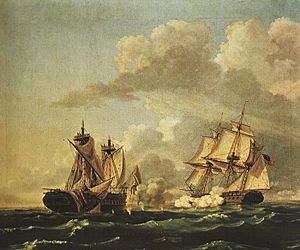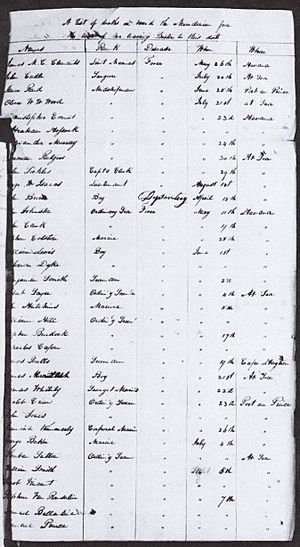HMS Macedonian facts for kids

The battle between the United States and the Macedonian, painted by Thomas Birch, 1813
|
|
Quick facts for kids History |
|
|---|---|
| Name | HMS Macedonian |
| Ordered | 28 September 1808 |
| Builder | Woolwich Dockyard |
| Laid down | May 1809 |
| Launched | 2 June 1810 |
| Out of service | 25 October 1812 |
| Fate | Captured |
| Name | USS Macedonian |
| Acquired | 25 October 1812 |
| Commissioned | April 1813 |
| Decommissioned | 1828 |
| Fate | Broken up, 1834 |
| General characteristics | |
| Class and type | Lively-class frigate |
| Tons burthen | 1082 bm |
| Length | 154 ft (47 m) |
| Beam | 38 ft 9 in (11.81 m) |
| Draft | 18 ft 4 in (5.59 m) |
| Propulsion | Sail |
| Complement | 306 |
| Armament | rated as 38 guns 28 × 18-pounder guns 14 × 32-pounder carronades |
The HMS Macedonian was a 38-gun frigate (a type of warship) in the Royal Navy of the United Kingdom. It was later captured by the USS United States during the War of 1812. This ship had an interesting journey, serving under two different navies.
Contents
Building and Early Days of the Macedonian
The Macedonian was built in England at Woolwich Dockyard in 1809. It was launched into the water on June 2, 1810. The ship officially joined the Royal Navy that same month. Its first commander was Captain Lord William FitzRoy. A 13-year-old boy named Samuel Leech was part of the original crew. He later wrote a book about his experiences on the ship.
Serving as HMS Macedonian
The Macedonian first sailed to Lisbon, Portugal. There, it helped protect against possible attacks from French ships. In February 1811, the Macedonian accidentally crashed into a British merchant ship called Ives. The Ives was so badly damaged that it caught fire. The crew of the Ives was rescued by the Macedonian.
Captain FitzRoy was later removed from his command. This was because he had been dishonest with the ship's records. He was replaced by William Waldegrave for a short time. Then, John Surnam Carden took over as captain. Captain Carden was popular with the crew because he hired a band for the ship.
In January 1812, the Macedonian was sent on a secret mission to Norfolk, Virginia. The goal was to bring back gold and silver to help the Bank of England. While in Norfolk, Captain Carden became friends with an American captain named Stephen Decatur. They even joked about their ships fighting. However, Captain Carden accidentally revealed the secret mission. So, the Macedonian had to return to Lisbon without the gold and silver.
In September 1812, the Macedonian was ordered to sail with another ship to Madeira. After that, it was supposed to look for enemy ships to capture.
The Battle with USS United States
On October 25, 1812, just a few days after leaving Madeira, the Macedonian met the USS United States. This American ship was commanded by Captain Stephen Decatur, Carden's friend from Norfolk. The United States had recently declared war on the United Kingdom. Both captains were ready for a fight.
The United States was a much larger and more powerful ship. It was a 44-gun heavy frigate. Its cannons could fire 864 pounds (392 kg) of metal in one shot. The Macedonian's cannons could only fire 528 pounds (239 kg). The United States turned to gain an advantage, making the Macedonian chase it.
Soon after the battle began, the powerful cannons of the United States destroyed all three of the Macedonian's masts. The hull of the ship was also badly damaged. The United States then moved away for a moment. This gave Captain Carden time to realize he had no choice. As the United States prepared to attack again, Captain Carden surrendered. This made the Macedonian the second British Royal Navy ship to be captured by the Americans during the war.
Becoming USS Macedonian
Captain Decatur made sure to save the captured Macedonian. He sent a team to help repair it, which took two weeks. On December 4, 1812, Decatur brought the captured ship into Newport, Rhode Island. This caused a huge sensation across the country. Another American ship, the USS Constitution, had previously captured a British ship. However, that ship was too damaged to save. The Macedonian was a valuable addition to the small US Navy.
The Macedonian was immediately taken into the United States Navy. It kept the name Macedonian and was commanded by Captain Jacob Jones.
In May 1813, the Macedonian, along with the United States and the sloop Hornet, tried to sail out to sea from New York. However, British ships were blocking the way. Captain Decatur decided to take his ships through Hell Gate, a difficult passage in New York. While sailing along Long Island Sound, the flagship United States was hit by lightning. This damaged its main mast. The Macedonian quickly moved away from the damaged ship.
After quick repairs, the ships continued eastward. But because of bad winds and a difficult passage for large ships, they reached Montauk Point. British ships were waiting for them there. Outmatched, the American ships had to turn back. They sailed to the Thames River, where they stayed until the end of the war.
On May 20, 1815, the Macedonian sailed to the Mediterranean Sea. It joined Commodore Decatur's squadron of 10 ships for the Second Barbary War in Algeria. This war was fought to stop pirates from bothering American merchant ships. On June 17, the frigate helped capture the Algerian flagship, the Mashuda.
After treaties were signed with Tunis and Tripoli, American ships were free to sail in the Mediterranean. For the next three years, the Macedonian patrolled there and off the East Coast of the United States.
From January 1819 to March 1821, the frigate operated off the Pacific coast of South America. It helped protect American merchant ships during a time of unrest. The ship returned to Boston in June 1821.
During this time, the Macedonian also acted like a banking ship. It did business with privateers, who were like legal pirates. The crew members often had to count large amounts of money. Many felt that Captain Downes, their commander, was doing this for his own benefit.
On April 2, 1822, the Macedonian left Boston as part of Commodore James Biddle's West Indies Squadron. Their mission was to protect American merchant ships and stop piracy. During this trip, 76 officers and men from the Macedonian died. Most of these deaths were from yellow fever. Commodore Biddle reported that many more crew members were sick. Because of this great loss, the squadron had to return to Norfolk Navy Yard early. The crew of the Macedonian received medical care and were kept separate at Craney Island.
The ship then cruised in the West Indies, helping to stop piracy until 1826.
On June 11, 1826, the Macedonian left Norfolk for service in the Pacific. It returned to Hampton Roads on October 30, 1828. The ship was officially taken out of service in 1828. It was then taken apart at the Norfolk Navy Yard. William Henry Leonard Poe, the brother of famous American writer Edgar Allan Poe, was part of the crew on this final voyage. The flag captured from HMS Macedonian was displayed at the U.S. Naval Academy. It was later removed for preservation in 2018.
Images for kids
See also
- USS United States vs HMS Macedonian
- List of frigate classes of the Royal Navy
- List of ships captured in the 19th century




